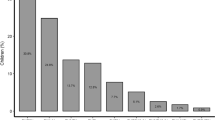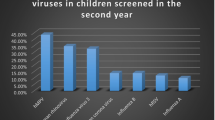Abstract
Most wheezing episodes in infants are caused and exacerbated by virus-induced lower respiratory tract infections. However, there are few reports of epidemiologic and clinical virus-specific research with a focus on virus-induced wheezing. The purpose of the current study was to characterize the clinical presentation of virus-induced wheezing in pediatric patients <3 years of age who were hospitalized with lower respiratory tract infections. Of the 412 patients in the study, 216 were followed for 3 years. Nasopharyngeal aspirates collected from the patients at the time of admission were examined for the presence of respiratory syncytial virus (RSV), rhinovirus (RV), parainfluenza-3 virus (PIV-3), human metapneumovirus (hMPV), and influenza virus (Flu) using reverse-transcription polymerase chain reaction and rapid diagnostic tests. Clinical signs were assessed using a severity scoring system. In patients with wheezing at the time of admission, RSV, RV, RSV+RV, Flu, PIV-3, and hMPV were detected in 33, 14, 8, 8, 5, and 3 % of samples, respectively. There were no differences in age and severity scores between patients harboring more prevalent viruses (RSV and RV) and those with less common infections. Patients with wheezing and RV-positive aspirates at the time of admission were more likely to develop subsequent wheezing during the following 3 years. Conclusion: RSV and RV infections are factors in the development and exacerbation of wheezing after virus-induced lower respiratory tract infections. Moreover, RV-induced wheezing may be associated with subsequent recurrent wheezing and the development of asthma.




Similar content being viewed by others
References
Bacharier LB, Cohen R, Schweiger T, Yin-Declue H, Christie C, Zheng J, Schechtman KB, Strunk RC, Castro M (2012) Determinants of asthma after severe respiratory syncytial virus bronchiolitis. J Allergy Clin Immunol 130:91–100
Bendelja K, Gagro A, Bace A, Lokar-Kolbas R, Krsulovic-Hresic V, Drazenovic V, Mlinaric-Galinovic G, Rabatic S (2000) Predominant type-2 response in infants with respiratory syncytial virus (RSV) infection demonstrated by cytokine flow cytometry. Clin Exp Immunol 121:332–338
Bont L, Aalderen WM, Kimpen JL (2000) Long-term consequences of respiratory syncytial virus (RSV) bronchiolitis. Paediatr Respir Rev 1:221–227
Bont L, Heijnen CJ, Kavelaars A, van Aalderen WM, Brus F, Draaisma JT, Geelen SM, Kimpen JL (2000) Monocyte IL-10 production during respiratory syncytial virus bronchiolitis is associated with recurrent wheezing in a one-year follow-up study. Am J Respir Crit Care Med 161:1518–1523
Bosis S, Esposito S, Niesters HG, Zuccotti GV, Marseglia G, Lanari M, Zuin G, Pelucchi C, Osterhaus AD, Principi N (2008) Role of respiratory pathogens in infants hospitalized for a first episode of wheezing and their impact on recurrences. Clin Microbiol Infect 14:677–684
Calışkan M, Bochkov YA, Kreiner-Møller E, Bønnelykke K, Stein MM, Du G, Bisgaard H, Jackson DJ, Gern JE, Lemanske RF Jr, Nicolae DL, Ober C (2013) Rhinovirus wheezing illness and genetic risk of childhood-onset asthma. N Engl J Med 368:1398–1407
Calvo C, García-García ML, Pozo F, Carvajal O, Pérez-Breña P, Casas I (2008) Clinical characteristics of human bocavirus infections compared with other respiratory viruses in Spanish children. Pediatr Infect Dis J 27:677–680
Chung JY, Han TH, Kim SW, Kim CK, Hwang ES (2007) Detection of viruses identified recently in children with acute wheezing. J Med Virol 79:1238–1243
Chung HL, Kim SG (2002) RANTES may be predictive of later recurrent wheezing after respiratory syncytial virus bronchiolitis in infants. Ann Allergy Asthma Immunol 88:463–467
Drosten C, Günther S, Preiser W, van der Werf S, Brodt HR, Becker S, Rabenau H, Panning M, Kolesnikova L, Fouchier RA, Berger A, Burguière AM, Cinatl J, Eickmann M, Escriou N, Grywna K, Kramme S, Manuguerra JC, Müller S, Rickerts V, Stürmer M, Vieth S, Klenk HD, Osterhaus AD, Schmitz H, Doerr HW (2003) Identification of a novel coronavirus in patients with severe acute respiratory syndrome. N Engl J Med 348:1967–1976
Ebihara T, Endo R, Kikuta H, Ishiguro N, Ishiko H, Hara M, Takahashi Y, Kobayashi K (2004) Human metapneumovirus infection in Japanese children. J Clin Microbiol 42:126–132
Ermers MJ, Janssen R, Onland-Moret NC, Hodemaekers HM, Rovers MM, Houben ML, Kimpen JL, Bont LJ (2011) IL10 family member genes IL19 and IL20 are associated with recurrent wheeze after respiratory syncytial virus bronchiolitis. Pediatr Res 70:518–523
Fujitsuka A, Tsukagoshi H, Arakawa M, Goto-Sugai K, Ryo A, Okayama Y, Mizuta K, Nishina A, Yoshizumi M, Kaburagi Y, Noda M, Tashiro M, Okabe N, Mori M, Yokota S, Kimura H (2011) A molecular epidemiological study of respiratory viruses detected in Japanese children with acute wheezing illness. BMC Infect Dis 11:168
García-García ML, Calvo C, Casas I, Bracamonte T, Rellán A, Gozalo F, Tenorio T, Pérez-Breña P (2007) Human metapneumovirus bronchiolitis in infancy is an important risk factor for asthma at age 5. Pediatr Pulmonol 42:458–464
García-García ML, Calvo C, Falcón A, Pozo F, Pérez-Breña P, De Cea JM, Casas I (2010) Role of emerging respiratory viruses in children with severe acute wheezing. Pediatr Pulmonol 45:585–591
Gern JE (2010) The ABCs of rhinoviruses, wheezing, and asthma. J Virol 84:7418–7426
Gern JE, Martin MS, Anklam KA, Shen K, Roberg KA, Carlson-Dakes KT, Adler K, Gilbertson-White S, Hamilton R, Shult PA, Kirk CJ, Da Silva DF, Sund SA, Kosorok MR, Lemanske RF Jr (2002) Relationships among specific viral pathogens, virus-induced interleukin-8, and respiratory symptoms in infancy. Pediatr Allergy Immunol 13:386–393
Houben ML, Coenjaerts FE, Rossen JW, Belderbos ME, Hofland RW, Kimpen JL, Bont L (2010) Disease severity and viral load are correlated in infants with primary respiratory syncytial virus infection in the community. J Med Virol 82:1266–1271
Hu A, Colella M, Tam JS, Rappaport R, Cheng SM (2003) Simultaneous detection, subgrouping, and quantitation of respiratory syncytial virus A and B by real-time PCR. J Clin Microbiol 41:149–154
Jackson DJ, Gangnon RE, Evans MD, Roberg KA, Anderson EL, Pappas TE, Printz MC, Lee WM, Shult PA, Reisdorf E, Carlson-Dakes KT, Salazar LP, DaSilva DF, Tisler CJ, Gern JE, Lemanske RF Jr (2008) Wheezing rhinovirus illnesses in early life predict asthma development in high-risk children. Am J Respir Crit Care Med 178:667–672
Jartti T, Gern JE (2011) Rhinovirus-associated wheeze during infancy and asthma development. Curr Respir Med Rev 7:160–166
Jartti T, Lehtinen P, Vanto T, Hartiala J, Vuorinen T, Mäkelä MJ, Ruuskanen O (2006) Evaluation of the efficacy of prednisolone in early wheezing induced by rhinovirus or respiratory syncytial virus. Pediatr Infect Dis J 25:482–488
Jartti T, Lehtinen P, Vuorinen T, Ruuskanen O (2009) Bronchiolitis: age and previous wheezing episodes are linked to viral etiology and atopic characteristics. Pediatr Infect Dis J 28:311–317
Kotaniemi-Syrjänen A, Vainionpää R, Reijonen TM, Waris M, Korhonen K, Korppi M (2003) Rhinovirus-induced wheezing in infancy—the first sign of childhood asthma? J Allergy Clin Immunol 111:66–71
Korppi M, Kotaniemi-Syrjänen A, Waris M, Vainionpää R, Reijonen TM (2004) Rhinovirus-associated wheezing in infancy: comparison with respiratory syncytial virus bronchiolitis. Pediatr Infect Dis J 23:995–999
Lehtinen P, Ruohola A, Vanto T, Vuorinen T, Ruuskanen O, Jartti T (2007) Prednisolone reduces recurrent wheezing after a first wheezing episode associated with rhinovirus infection or eczema. J Allergy Clin Immunol 119:570–575
Lemanske RF Jr (2002) The childhood origins of asthma (COAST) study. Pediatr Allergy Immunol 13:38–43
Lemanske RF Jr, Jackson DJ, Gangnon RE, Evans MD, Li Z, Shult PA, Kirk CJ, Reisdorf E, Roberg KA, Anderson EL, Carlson-Dakes KT, Adler KJ, Gilbertson-White S, Pappas TE, Dasilva DF, Tisler CJ, Gern JE (2005) Rhinovirus illnesses during infancy predict subsequent childhood wheezing. J Allergy Clin Immunol 116:571–577
Louie JK, Roy-Burman A, Guardia-Labar L, Boston EJ, Kiang D, Padilla T, Yagi S, Messenger S, Petru AM, Glaser CA, Schnurr DP (2009) Rhinovirus associated with severe lower respiratory tract infections in children. Pediatr Infect Dis J 28:337–339
Message SD, Laza-Stanca V, Mallia P, Parker HL, Zhu J, Kebadze T, Contoli M, Sanderson G, Kon OM, Papi A, Jeffery PK, Stanciu LA, Johnston SL (2008) Rhinovirus-induced lower respiratory illness is increased in asthma and related to virus load and Th1/2 cytokine and IL-10 production. Proc Natl Acad Sci U S A 105:13562–13567
Midulla F, Pierangeli A, Cangiano G, Bonci E, Salvadei S, Scagnolari C, Moretti C, Antonelli G, Ferro V, Papoff P (2012) Rhinovirus bronchiolitis and recurrent wheezing: 1-year follow-up. Eur Respir J 39:396–402
Pala P, Bjarnason R, Sigurbergsson F, Metcalfe C, Sigurs N, Openshaw PJ (2002) Enhanced IL-4 responses in children with a history of respiratory syncytial virus bronchiolitis in infancy. Eur Respir J 20:376–382
Price JF (1990) Acute and long-term effects of viral bronchiolitis in infancy. Lung 168:414–421
Scheltinga SA, Templeton KE, Beersma MF, Claas EC (2005) Diagnosis of human metapneumovirus and rhinovirus in patients with respiratory tract infections by an internally controlled multiplex real-time RNA PCR. J Clin Virol 33:306–311
Schuurhof A, Janssen R, de Groot H, Hodemaekers HM, de Klerk A, Kimpen JL, Bont L (2011) Local interleukin-10 production during respiratory syncytial virus bronchiolitis is associated with post-bronchiolitis wheeze. Respir Res 12:121
Singh AM, Moore PE, Gern JE, Lemanske RF Jr, Hartert TV (2007) Bronchiolitis to asthma: a review and call for studies of gene-virus interactions in asthma causation. Am J Respir Crit Care Med 175:108–119
Takeyama A, Hashimoto K, Sato M, Sato T, Kanno S, Takano K, Ito M, Katayose M, Nishimura H, Kawasaki Y, Hosoya M (2012) Rhinovirus load and disease severity in children with lower respiratory tract infections. J Med Virol 84:1135–1142
Valkonen H, Waris M, Ruohola A, Ruuskanen O, Heikkinen T (2009) Recurrent wheezing after respiratory syncytial virus or non-respiratory syncytial virus bronchiolitis in infancy: a 3-year follow-up. Allergy 64:1359–1365
Van Piggelen RO, van Loon AM, Krediet TG, Verboon-Maciolek MA (2010) Human rhinovirus causes severe infection in preterm infants. Pediatr Infect Dis J 29:364–365
Watts KD, Goodman DM (2007) Wheezing in infants: bronchiolitis. In: Kliegman RM, Behrman RE (eds) Nelson textbook of pediatrics, 18th edn. Saunders, Philadelphia, pp 1773–1777
Watzinger F, Suda M, Preuner S, Baumgartinger R, Ebner K, Baskova L, Niesters HG, Lawitschka A, Lion T (2004) Real-time quantitative PCR assays for detection and monitoring of pathogenic human viruses in immunosuppressed pediatric patients. J Clin Microbiol 42:5189–5198
Welliver RC, Sun M, Rinaldo D, Ogra PL (1986) Predictive value of respiratory syncytial virus-specific IgE responses for recurrent wheezing following bronchiolitis. J Pediatr 109:776–780
Welliver RC, Duffy L (1993) The relationship of RSV-specific immunoglobulin E antibody responses in infancy, recurrent wheezing, and pulmonary function at age 7-8 years. Pediatr Pulmonol 15:19–27
Wright PF, Deatly AM, Karron RA, Belshe RB, Shi JR, Gruber WC, Zhu Y, Randolph VB (2007) Comparison of results of detection of rhinovirus by PCR and viral culture in human nasal wash specimens from subjects with and without clinical symptoms of respiratory illness. Clin Microbiol 45:2126–2129
Wu P, Hartert TV (2011) Evidence for a causal relationship between respiratory syncytial virus infection and asthma. Expert Rev Anti Infect Ther 9:731–745
Acknowledgments
We thank Honzumi K and Tanji M for their technical support. We also thank the staff of the pediatric unit of the Soma General Hospital for their assistance with sample collection.
Conflicts of interest and source of funding
This work was supported in part by the Japan Society for the Promotion of Science.
Author information
Authors and Affiliations
Corresponding author
Additional information
Communicated by Willem Proesmans
Rights and permissions
About this article
Cite this article
Takeyama, A., Hashimoto, K., Sato, M. et al. Clinical and epidemiologic factors related to subsequent wheezing after virus-induced lower respiratory tract infections in hospitalized pediatric patients younger than 3 years. Eur J Pediatr 173, 959–966 (2014). https://doi.org/10.1007/s00431-014-2277-7
Received:
Revised:
Accepted:
Published:
Issue Date:
DOI: https://doi.org/10.1007/s00431-014-2277-7




